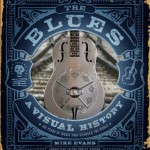The Blues: A Visual History. 100 Years of Music that Changed the World
 The Blues is a slippery topic for any writer. Just when you think you have a good bead on it, it’ll pack up its stakes and move down the road, and any author who promises to provide his readers with “a visual history” of a topic as wide and deep as The Blues takes on a daunting chore. Fortunately though, Mike Evans’s The Blues: A Visual History succeeds on nearly every front. Evans uses important historical images, (handbills, photographs, record covers and labels, etc.), clear, sharp storytelling, and detailed biographical profiles of major musical contributors — from Leroy Carr to Gary Clark, Jr. — to tell the story of The Blues and its influence on American musical culture — an effect that, frankly, is hard to overestimate. As Evans argues in his introduction: “[T]he influence of the blues has been felt in every aspect of contemporary music, from soul to hip-hop, alternative rock to straight pop.”
The Blues is a slippery topic for any writer. Just when you think you have a good bead on it, it’ll pack up its stakes and move down the road, and any author who promises to provide his readers with “a visual history” of a topic as wide and deep as The Blues takes on a daunting chore. Fortunately though, Mike Evans’s The Blues: A Visual History succeeds on nearly every front. Evans uses important historical images, (handbills, photographs, record covers and labels, etc.), clear, sharp storytelling, and detailed biographical profiles of major musical contributors — from Leroy Carr to Gary Clark, Jr. — to tell the story of The Blues and its influence on American musical culture — an effect that, frankly, is hard to overestimate. As Evans argues in his introduction: “[T]he influence of the blues has been felt in every aspect of contemporary music, from soul to hip-hop, alternative rock to straight pop.”
Roughly, Evans structures his book chronologically, beginning with the pioneers of early blues — the music and musicians rooted in the African call-and-response genre, European church music, the minstrel traditions, and ragtime. Evans then explains in fine detail how these elements, in the context of plantation life and the reconstruction period that followed The Civil War, matured and then he guides us through the migration of The Blues up the Mississippi delta through Memphis, St Louis, and finally Chicago.
One of the strengths of the book lies in its ability to please both seasoned students of The Blues and casual fans. For instance, in a superb section Evans discusses “Hollers, Shouts, and Spirituals” through examining the connection between the “field holler,” and “ring shout” and their relation to early slave spirituals. Evans explains that “another musical trope that emerged from the rural South — the field holler — was equally significant in the birth of the blues. Unlike a worker on a railroad gang or other group effort, a field hand did not have to coordinate with his fellow workers. He sang at his own speed, while others echoed his often wordless call or “holler.” This is just one of many fascinating explanations that emerge from the book.
After highlighting the basic development of the blues, in later chapters Evans begins expanding his discussion to explore the influence of the blues upon later genres, e.g., country music, heavy metal, folk music, blues rap, and rock. Through quotes from various musicians and his own skillful analysis, he makes a solid case for that influence. Evans selects a quote from Keith Richards’ autobiography Life to make his point: “If you don’t know the blues . . . there’s no point in picking up the guitar and playing rock and roll or any other form of popular music.” That’s a pretty good argument from a pretty good source.
The Blues: A Visual History is not flawless though. The book leans heavily upon popular culture for its context, yet there’s only a minor mention of The Blues Brothers (a small note while discussing Cab Colloway’s career). While some dismiss The Blues Brothers as musically illegitimate, essentially a comic novelty act, arguably that band and the film had a hand in introducing and promoting The Blues to new generations of fans. A small acknowledgment of that would’ve done no harm.
But this is simply a quibble; overall Mike Evans, along with consulting editor Robert Gordon, has put together a superbly entertaining book that will add to anyone’s knowledge and enjoyment of the blues — highly recommended.
The Blues: A Visual History. 100 Years of Music that Changed the World
Mike Evans, Author; Robert Gordon, Consulting Editor; Forward by Marshall Chess. Sterling Publication, 256 pages. $29.95.
